Wit’s End: In 2020, a Pet Dragon Is Role Model of the Year
I never wanted to own a bearded dragon. It seemed like the kind of pet Morticia Addams would have: a scaly reptile that hulked inside a tank, one yellow eye fixed on you with hostile indifference.
I preferred likeable forms of animal life, like dogs and kittens. I might, in theory, enjoy an exotic bird, but a lizard held no emotional or aesthetic appeal.
When I was a kid, the bearded dragon’s close relative, the horned toad, often darted across our front porch in the summer. Sometimes we’d catch one and see if we could make it shoot blood out of its eyes: an evolutionary trick to ward off predators. When a coyote attacks the horned toad, one writer explained, “a stream of nasty-tasting blood squirts from the lizard’s eyes, straight into the coyote’s mouth. The coyote steps back, shaking its head from side to side in disgust.”
It never occurred to me to bring one of these things inside the house. My room was a sanctuary of books, toys, and the flowery sundresses I favored. Lizards belonged outside where they would eventually get run over by a car, whatever. Now, where was my rose-patterned tea set?
But suddenly, it was 2020 and I had a daughter of my own. When school and sports shut down in March, she turned to animal shows to pass the time, including a charismatic YouTuber who talked about her bearded dragon, Fitz.
For a tween living under house arrest, it could be worse, I figured. My 11-year-old was not watching Kardashian makeup tutorials or listening to the unbelievably vulgar songs climbing the pop charts. (Seeing the lyrics, I stepped back, shaking my head side to side in disgust.)
Inevitably, though, she began lobbying for her own “beardie.” Though she’d always seemed like a laid-back Californian, suddenly she was giving commanding PowerPoint presentations, selling the idea like a dot-commer to a room of venture capitalist billionaires. She handed out summaries of her research and held Q&A sessions to address our concerns.
Basically, she wore us down. When we green-lighted her idea to buy a newly hatched bearded dragon from a breeder downstate, she burst into tears of joy. It had been a hard slog, but victory was hers!
We met the baby beardie at a FedEx center by the airport, where it had been shipped overnight in a small box. Vaguely jealous that it was still allowed to travel, we signed the papers and took it home. It was a tiny, slender thing, four inches long from tip to tail. We placed it in a well-lit tank, outfitted with its own furniture like a condo.
And so began a new phase of our lives: cohabiting with a reptile. In a stressful and contentious year, when everyone had reverted to their lizard brains, how bad could an actual lizard be?
In fact, the dragon was a model of poise and dignity. It spent a lot of time basking on a rock under a sun lamp. It ate coleslaw mix and live crickets, rousing itself from days of torpor to snap them up with astonishing speed. It often sat in my daughter’s palm or on her shoulder, and seemed to enjoy baths in the bathroom sink.
We could tell when the lizard was nervous because her white underbelly turned splotchy and black. Simple tricks — like papering over the glass tank to reduce visual stimulation, or leaving her alone to furtively poop in her food dish — cheered her up.
If only humans were so simple! Instead of changing color when stressed out, I dashed off angry letters and bought things I didn’t need on the Internet. Perhaps I, too, was overstimulated and should turn off my phone? Life in 2020 was unsettling to both me and the beardie, but her primitive emotions were easier to manage. She was a pro at finding satisfaction in the little things, like munching freeze-dried mealworms or watching the dog leave the room.
On my Zoom calls for work, people frequently asked about the lizard. Everyone was either getting a new pet or thinking about getting one, spooked by the ringing emptiness of their apartments or alarmed that their children spent 15 hours a day on screens. All over town, people were hauling home puppies, gerbils, parakeets, ferrets, snakes, and white mice and giving them 2020 names like Gaslight and Desesperación.
In a tough year, we found, living with animals was therapeutic. Lizards had been around 300 million years. To paraphrase a Victorian writer describing the Mona Lisa, our beardie was “older than the rock on which she sat.” As we humans gripped the rail of the roller coaster that was 2020, our lizard reminded us of a different reality: impassive, ancient, and unchanging. The natural world was not our silly world, and it took the long view.
So many things in 2020 made me step back, shaking my head in disgust, but when I look at our bearded dragon these days, I think: “She’s kind of cute.”
Featured image: ifong / Shutterstock
Ask the Vet: Stay Out of Green Water!
Question: Kip, my retriever mix, loves to swim in a nearby lake, but the water recently turned green. Is it safe for him to swim?
Answer: I recommend you keep Kip from drinking or swimming in green water; the color may mean it’s contaminated with blue-green algae called cyanobacteria. Some species of cyanobacteria produce toxins that can sicken or kill animals and humans. Cyanobacteria live in both salt and fresh water and thrive in warm, calm water. When an animal ingests contaminated water, algae, or fish, toxins are released and quickly absorbed and circulated throughout the body, causing liver damage and neurotoxicity. Clinical signs can begin within minutes and include diarrhea, weakness, muscle tremors, paralysis, and seizures. Death can occur within a few hours.
Ask the Vet is written by veterinarian Lee Pickett, VMD. Send questions to [email protected] and read more at saturdayeveningpost.com/ask-the-vet.
This article is featured in the September/October 2020 issue of The Saturday Evening Post. Subscribe to the magazine for more art, inspiring stories, fiction, humor, and features from our archives.
Featured image: PJ photography / Shutterstock
Ask the Vet: Safer Chew Toys
Question: Baxter, my 5-year-old retriever mix, broke a tooth while gnawing on a bone, and the vet said his enamel was badly worn, probably from chewing on tennis balls. Can you suggest safer chew toys?
Answer: The nylon fuzz on tennis balls damages enamel in two ways: It’s abrasive even when clean, and it picks up dirt that acts like sandpaper on teeth. The lesson: Anything harder than teeth breaks teeth. The list includes natural and nylon bones, dried pig ears, hard plastic chew toys, and even ice cubes. Safe chew toys, the rubber kind, have some “give.” (Kong black toys are good for power chewers.) Offer Baxter a twisted rope toy and some dental chews. Also, increase his physical activity to tire him out before he settles down for a chew.
Ask the Vet is written by veterinarian Lee Pickett, VMD. Send questions to [email protected] and read more at saturdayeveningpost.com/ask-the-vet.
This article is featured in the July/August 2020 issue of The Saturday Evening Post. Subscribe to the magazine for more art, inspiring stories, fiction, humor, and features from our archives.
Featured image: Photology1971 / Shutterstock
Your Health Checkup: COVID-19 and Other Pet Health Concerns
“Your Health Checkup” is our online column by Dr. Douglas Zipes, an internationally acclaimed cardiologist, professor, author, inventor, and authority on pacing and electrophysiology. Dr. Zipes is also a contributor to The Saturday Evening Post print magazine. Subscribe to receive thoughtful articles, new fiction, health and wellness advice, and gems from our archive.
Order Dr. Zipes’ new book, Bear’s Promise, and check out his website www.dougzipes.us.
I love animals and have had dogs as pets for many years. It’s important to keep your pets healthy since on occasion they can make you sick through bites, scratches, or other direct contact of human skin or mucous membranes such as the mouth or tongue. Other sources of exposure include contact with animal saliva, urine, and other body fluids or secretions, inadvertent ingestion of animal fecal material, inhalation of infectious aerosols or droplets, and through the bite of a spider, flea, tick, and other similar vectors harbored by the pet.
The following are some examples of the more than 70 diseases in humans that can be caused by animals.
- COVID-19 is known to spread from humans to dogs and cats. While there is no credible information that the animal can pass the infection back to humans, an abundance of caution suggests you should isolate from your pet if you become infected with the COVID virus.
- Ringworm is a contagious fungal infection that presents as a circular rash and can be spread to humans from many different animals as well as from human to human. It is usually treated with topical antifungal agents.
- Lyme disease is caused by the bite of blacklegged (deer) ticks infected with the bacterium Borrelia burgdorferi. While dogs and cats with Lyme disease cannot spread it to humans, they may harbor the ticks in their fur that can infect humans.
- Parasitic worms such as roundworms can infect dogs and cats and be passed to humans in animal feces containing worm eggs. Careful disposal of animal excrement while wearing gloves and thorough hand washing is recommended.
- Cat scratch fever is an infection caused by the bacterium Bartonella henselae, and is carried by 40 percent of cats at some point in their lives. It is spread to humans by cats licking an open wound or a scratch or bite that opens the skin. Avoiding cats licking an open wound and washing a cat scratch or bite thoroughly with soap and water and applying an antiseptic is recommended.
- Toxoplasmosis is caused by a microscopic parasite, especially common in cats, that can spread to humans in contact with the animal feces. It can cause significant harm to the fetus in pregnant women but is typically not significant in otherwise healthy people. As noted above, careful cleanup of animal feces such as the cat litter box is a must, and pregnant or soon-to-be-pregnant women are advised to avoid cleaning the litter box at all.
- Leptospirosis is caused by a bacterium found in the urine of many animals and can spread to humans in contact with the animal urine or drinking infected water.
- Salmonellosis is usually a gastrointestinal infection caused by a bacterium that lives in the intestinal tract of animals. While salmonella infection is most commonly transmitted by ingesting infected food sources, pets such as chickens and other birds, turtles, frogs, dogs, cats, and horses can transmit the disease.
- Psittacosis is bacterium causing parrot fever from infected parrots, pigeons, and many species of birds that presents as a severe pneumonia. The infection routes are by mouth-to-beak contact, or through the airborne inhalation of feather dust, dried feces, or the respiratory secretions of infected birds.
- Methicillin resistant staph aureus bacterial infections can be transmitted from dogs, cats, birds and other animals to humans and vice versa.
- Rabies is a deadly virus spread to humans in the saliva of an infected animal, usually transmitted through an animal bite.
How to Prevent Infections from Animals to Humans
- The number one recommendation is to wash hands vigorously after contact with animals or their waste
- Keep a pet healthy and free from infections with appropriate vaccinations, flea and tick prevention, and regular veterinarian checkups
- Wear gloves to clean up animal feces and wash hands thoroughly afterward
- Dispose of animal waste in plastic bags in appropriate containers
- Wash pet bedding regularly and clean litter boxes or cages frequently
- Clean high contact surfaces such as countertops and tables and avoid food contamination with pet waste
- Don’t let animals lick human open wounds or mucous membranes (e.g. mouth, tongue)
Pets are wonderful companions and help us live longer, healthier, and happier lives. Enjoy them, love them, but remember that certain precautions to keep you and your pet healthy are warranted.
Featured image: shulgenko / Shutterstock
Don’t Call Them the Dog Days of Summer
I hate the downside of summer as much as anyone. The heat. The humidity. Heat indexes off the charts.
I have also come to have a strong dislike for the meteorologists who stand at their weather maps with the dazzling displays of incoming low fronts or stalled high fronts and wrap up the forecast for another week of high temperatures and oppressive humidity with a dismissive: “It’s the dog days of summer.”
The term goes back to Ancient Greece and Rome. Astrologically attuned to the heavens, the Greeks and Romans noticed that the star Sirius (dog) rose with the sun in the hot days of summer, and linked the star and heat. In Anglo-Saxon times, the “dog days of summer” ran from July 14- September 5. The Old Farmer’s Almanac says July 3-August 11.
And on behalf of Tippy, Topsy, and Taffy, “Honeybubs” (long story), Toby, and Tinker Bell, Tracy, Tuppence, and Mr. Buttons, the dogs that have so enriched my 94 years, not forgetting my current Cocker Spaniel, Winston, I have to protest the calling of the worst days of summer “dog days.”

Dogs deserve better.
All 76,811,305 of them. That’s the number listed by the American Veterinary Medical Foundation, which notes that almost 50 million households own a dog. (That’s 38.4 percent for the statistically minded.) How much we care for (and about) them may be deduced from the $95.7 billion we spent on them in 2019 for food, medicines, supplies, veterinary care, grooming, and boarding, according to the American Pet Products Association. The estimated total for 2020 is $99 billion. If you’re not up on your Department of Defense prices, $75.38 billion will get you two of the new Gerald R. Ford-class nuclear aircraft carriers.
Our love of dogs is truly writ large.
Calvin Coolidge, the 30th president of the United States, was clear: “Any man who does not like dogs and want them about does not deserve to be in the White House.”
The great majority of presidents have had dogs. George Washington, in fact, is not only the father of our country but of the American Foxhound. He imported some Foxhounds from England, and then the Marquis de Lafayette gave him some French hounds for breeding.
Theodore Roosevelt had a veritable menagerie, many of them his children’s dogs, but the leader of the Rough Riders, not surprising for such an outsized figure in our history, had a typically outsized dog — a Saint Bernard, named Rollo. (His son Kermit’s Manchester Terrier, Blackjack, is reported to have ripped the pants of a French ambassador.)
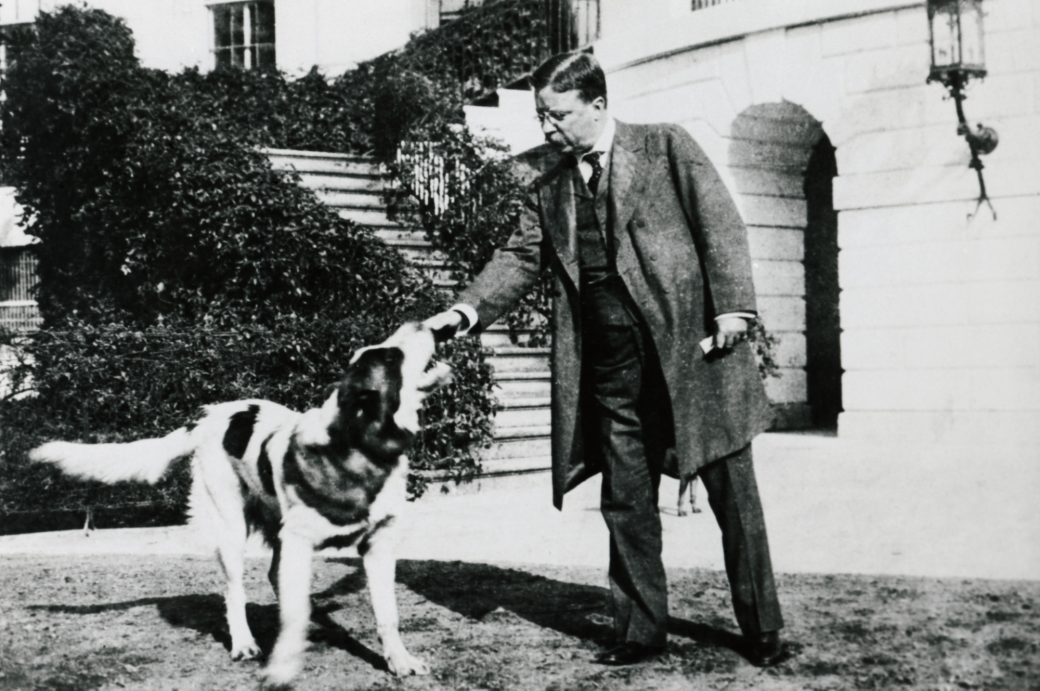
Although he, too, met many a dignitary, Fala, the Scottish Terrier that was a gift to President Franklin D. Roosevelt in 1940, apparently was better mannered and became far more famous. Certainly, he was photographed often enough. Today, Fala may still be seen keeping his master company, this time sitting a few feet from him in the National Memorial to President Franklin D. Roosevelt in the nation’s capital — the only pet ever represented in a presidential memorial.

President George W. Bush brought another Scottie to the White House, Barney. Come Christmas time, with the help of an aide who followed with a video camera, Barney gave Americans a tour of the White House, the greens on the mantels, the fruit arrangements in the state rooms, and the big, beautifully decorated Christmas tree.
Had my black Cocker Spaniel Topsy had an aide videotaping her by the Christmas tree in our white clapboard house, it would have gone viral today. For while Topsy, a year old when I bought her with my high school graduation money, had been welcomed into the family by my parents and me, not so by my cat, Blinkee Puss. She spent most of those first summer weeks under the living room daybed. On Christmas Eve, Blinkee Puss was lying on the floor near me when Topsy approached to play … to her, a threatening move. And what does a cat do at a time like that? Look for a tree.
I can tell you, 78 years later, there was never any doubt about when she landed or how high she climbed. It gives new meaning to living Christmas tree. The branches bounced. The lights — the old red, yellow, blue, green Technicolor lights — danced. The tinsel shivered. The ornaments oscillated.
Fast forward five years. My father had been transferred. Topsy and Blinkee Puss had found a new home with a neighbor who would take both of them, because they’d grown so close no one wanted to split them up. Our Christmas tree was in a Chicago apartment. And I, now working for the Chicago Daily News, had used the bonus I received for our student press conference with President Harry S. Truman — the first, and to date, only formal press conference ever granted by a sitting President to student newspaper editors — to buy a three-month-old buff and white Cocker Spaniel puppy. He was named Taffy; understandably, his AKC papers listed him as Cavalier of Caramel.
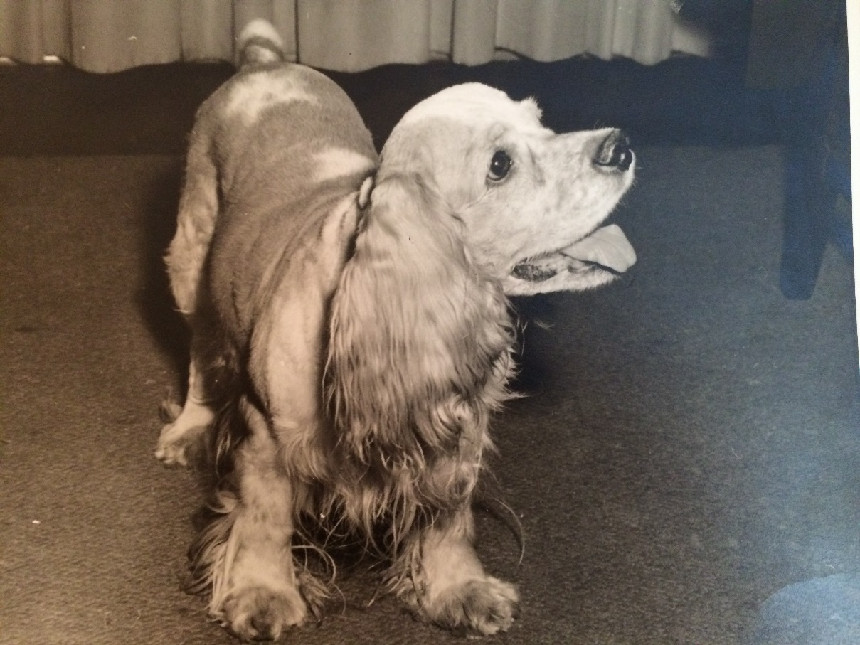
Charles Schulz, creator of Peanuts, and thereby Snoopy, summed it all up nicely. “Happiness is a warm puppy.” If you prefer the more literary approach, there’s Rudyard Kipling. “Buy a pup and your money will buy love unflinching.” I offer as proof — certifiable, verifiable proof — Taffy’s second Christmas with us.
I’d suffered from pneumonia most of the fall and had only been back to work a few days when I noticed the receptionist coming through the frosted double doors to the Chicago Daily News editorial offices with a tantalizing array of beautifully wrapped Christmas presents. Sometimes his arms were filled with the gifts from people and organizations who’d dealt with the various editors, writers, and columnists during the year and wished to show their gratitude and appreciation. As the week wore on, I became all too aware that not one, as yet, was for me.
I later read that a bout with pneumonia leaves a person not only physically weakened but emotionally sensitive. I like to think that explains it. By week’s end I was on the verge of tears all the way home, and once there let them flow. My mother tried to comfort me. Taffy came over in great concern.
Then … Taffy went to the Christmas tree, surveyed the array of gifts beneath the lower branches, and finding one small enough to pick up, he turned and waddled back, sitting up (one of his best tricks) in front of me with his offering.
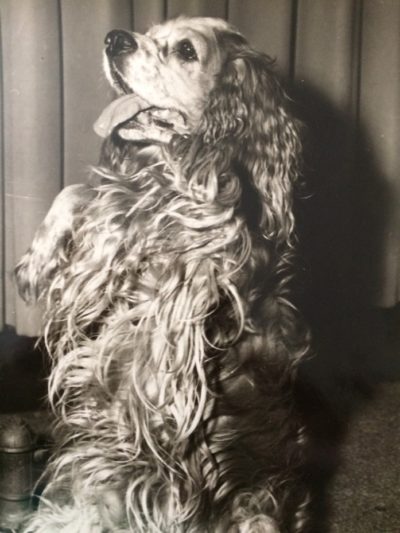
Well, I wasn’t that sorry for myself.
I reached down to take it. After a bit, my mother headed for the kitchen to start dinner. Then, the sadness returned, the tears. Taffy went back to the tree, selected another of the gifts and brought it over, sitting up to present it to me.
We had him for almost 16 years, and never before nor during any of the Christmases that followed did he so much as touch a present under the tree.
I still wonder at how he knew.
But he did.
Dogs do. In ways we don’t know or understand, but recognize.
“I have found,” said Doris Day, star of so many lighthearted movie comedies, “that when you are deeply troubled, there are things you get from the silent devoted companionship of a dog that you can get from no other source.”
General Dwight D. Eisenhower, Supreme Commander of the Allied Forces in Europe in World War II — later, the 34th president of the United States — agreed wholeheartedly. He said, “The friendship of a dog is precious. It becomes even more so when one is so far removed from home …. I have a Scottie. In him I find consolation and devotion … he is the one person to whom I can talk without the conversation coming back to war.”
Some are formally called Comfort Dogs. The 23 Golden Retrievers flown to Orlando, Florida, to comfort the victims’ families following the tragedy at the Pulse club June 12, 2016, were part of a larger comfort corps — a program to provide canines for victims.
Some are Service Dogs. Who can forget the yellow Labrador who came into the home of President George Herbert Walker Bush following Barbara’s death to keep the 41st president company, watch over him. And who continued after his passing — photos without end showing him in the rotunda of the Capitol as the former president lay in state, the servicemen in their uniforms at the four corners, and Sully as close as he could still get to his master.
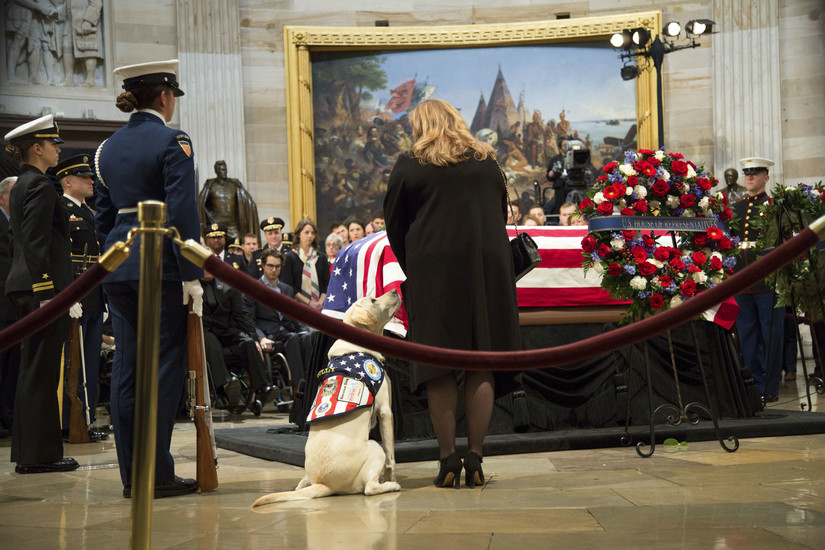
Others are Rescue Dogs. The death of the last surviving dog to work the site of the World Trade Center after 9/11, Bretagne, a Golden Retriever, was widely reported when she died June 6, 2016 — just shy of 17. She was two when she was deployed to Ground Zero as part of the Texas Task Force. She later helped with search and rescue in New Orleans after Hurricane Katrina.
Whatever the category of service, the role that dogs may play in our lives was key to a medical study in a PBS documentary from some years ago. Doctors had noticed that certain patients who survived a heart attack went on to live longer and more productive lives than others. Was there a reason?
Stopping to pick up a friend at the bus station, one of the doctors chanced to notice a man sitting on a bench in the waiting room, his dog seated beside him on the floor, the man stroking the dog’s head, absently, lovingly, clearly for the zillionth time. The doctor realized it was an unusual possibility. But he mentioned it to his colleagues at their next meeting. However taken aback, they’d found nothing else. They decided to check … and found their common denominator: a dog.
So forget “Dog days.” Here’s to dogs every day!
Winston seconds that.s
Featured image: Detail from “Backyard Dog Show” by Amos Sewell, from the July 8, 1950, cover of the Post (© SEPS)
At the Apex, Purring Madly
Yes, I was foolish. Reckless too. But I don’t think I would have done anything different, even now that I can see the bigger picture.
Maybe I wouldn’t have been so vulnerable if I hadn’t just lost my cat, Jingle Monster – and a year before that, my dog, Tulip. I felt so grieved. I didn’t try to adopt new pets. How could I, knowing how much it would hurt when they died? How could I see their trust in me, their hope that I could help them when they were feeling bad? That’s what killed me, seeing their hope give way to despair. No sir. Not again.
That’s what I told myself. Yet I didn’t get rid of the cat food. That was my first mistake.
I work from a home office. If you’ve ever seen those clickbait titles online that say things like “15 Ways to Cut Belly Fat RIGHT NOW!”, I write a lot of those. Don’t get me wrong, I don’t actually know how to cut belly fat, but I’m good at research, and even better at making suggestions to people that sound plausible. In my defense, I stay away from recommendations that might kill people.
I’m very good at what I do, but I need to come up for air from time to time, so late one morning, six weeks from the day Jingle died, I wandered into the kitchen for a coffee break. I fixed my cup and leaned against the counter to drink it, listening to a house that had grown too quiet.
Funny how a little guy who had weighed less than five pounds could make such a giant hole in my life now that he was gone. Jingle had a meow that was far too big for his body. He used it when he felt I had spent too much time in the office and not enough time paying attention to a Jingle Monster.
I couldn’t help listening for that meow, though I no longer expected to hear it. That’s the only reason I heard the other sound. It was coming from the laundry room. I went to the door and paused at the threshold.
Crunch, crunch, crunch came from under the utility shelf where I stored Jingle’s dry food, and I wondered just how big the mouse was. Could it be a rat? I had never seen a rat in Arizona, except for the tiny, wild variety.
I got down on my knees and prepared to peer under the shelf, bracing myself for years of dust-bunny build-up. Before I could do that, something looked out at me.
Ho boy, I thought. Two kitty-cat eyes were framed in grey, velvet fur, tilted in that irresistible Hello Kitty way that turns otherwise sensible people into suckers. As soon as it saw me, it began to purr. A kitten had smelled the kibble I should have cleaned out from under that utility shelf, weeks ago. I was lucky the food hadn’t attracted a rat, but then maybe it had, and then the rat had attracted …
Wait a minute, I thought. How come Kitty has legs growing out of her head?
I backed up. The purring continued, but Kitty’s eyes were oddly unmoving. On closer inspection, I could see that they were markings.
Biomimicry, I thought to myself. I had even written articles about it, but I still hadn’t thought it all the way through.
She moved into the light – backed into it, actually, because what appeared to be Kitty’s head turned out to be her abdomen. As she emerged, I counted four legs, then six, then eight. She pivoted and stared at me (for real, this time) with four small orbs surrounded by several tiny ones. She had big, furry mandibles.
Damned if she wasn’t also kind of cute. She even had little pads on her feet that made them look like tiny kitty paws.
“Awww,” I said, warily.
Kitty-cat spider seemed way too friendly. When I inspected her business end (where she ate), I could see her impressive fangs would likely inject a potent toxin. Once she incapacitated me with that bite, she could feast on my face at her leisure, purring madly the whole time.
Or was the purr for my benefit, to put me at ease? Maybe she wouldn’t bother with it, once I was helpless.
“You’re amazing,” I had to admit. I wondered if I should grab my phone and take a picture of her. Would I find something like her online? Was she a new species? Even if she wasn’t, she would make a good article. In fact, Kitty was so interesting, so oddly cute, she might even become an online sensation …
She flexed her jaws, reminding me that biomimicry was also a predatory attribute. I started back, and so did she. Kitty disappeared under the shelves. I caught my breath, and then peered underneath to see where she had gone, ready to escape if she moved in my direction. I didn’t know it then, but I could not possibly have moved away in time if Kitty had decided to bite me.
Kitty was gone.
You’ve already named her. I got to my feet, shaking my head. Is that sensible? Did you see her fangs? What are you going to do about her?
You would think I would kill or capture her, right? But no, I worried about the safety and health of kitty-cat spider. After all, she was only doing what nature had designed her to do. True, I didn’t want her to do that to me, but at least I could make sure she wasn’t harmed.
Yep. That’s me. Defender of kitty-cat spiders who might eat my face.
I kept an eye out for Kitty all day, and well into the evening. I didn’t search for her anymore, because I had a feeling I had provoked her hiding instinct. If I were a kitty spider, I would lay low and wait for the human to fall asleep. A predator her size is also prey, and I assumed that her spider wiring must have equipped her with millions of years of survival strategies.
Hunting strategies, too. The idea of going to bed without knowing where she was made me feel pretty twitchy. She wouldn’t even have to inject me – if I woke up with an eight-legged Kitty on my face, I would have a heart attack. However, a strategy occurred to me as the day wound down and night crept over my neighborhood.
I have a sleeping bag that’s designed to keep scorpions and other venomous bugs from getting to you when you’re camping. You can seal yourself into it from head to toe, and it has mesh for breathing. So I hauled it out of its closet.
I peeked into the hallway. Nothing moved on the floor, so I carried the bag to my bed. I didn’t bother to turn down the covers. I sealed myself inside, sure that I would be safe from Kitty’s ultra fangs.
Pretty sure. Almost certain.
It wasn’t the most comfortable way to sleep, but I felt grateful for it. Just before I was about to drop off, I head skittering noises. Something small climbed onto my sleeping bag and moved around, as if trying to figure out where I was. Finally it settled in one spot, just where Jingle would have curled up, and I heard another noise.
Purring.
“Oh, that’s fiendish,” I said, and then I fell asleep.
I was afraid to move all night, mostly because I worried I might squish Kitty. When morning came, I worried about something else, because she was gone. I emerged from the sleeping bag, half-expecting her to leap at my face, once it was no longer protected. She was nowhere in sight.
Outside, someone roared with anger, and I heard a crash, then the sound of something breaking. My neighbor Thor was at it again. He hated the cats that invaded his flower garden, and he had thrown many a pot at the four-footed rascals. To be fair, it was a gorgeous garden, and cats do have a tendency to poop where you don’t want them to. I had done my best to keep Jingle inside, partly to save Thor’s garden and partly to save Jingle. My cat had a fiendish side, and he enjoyed tormenting our next-door neighbor a little too much.
Just imagine what Thor would think of Kitty! The only thing he hated more than cats were bugs.
I heard another crash, but I suspected Thor was venting anger at this point. He always had that to spare. If he didn’t have a garden to occupy his time, he might have spent it building bombs instead.
I walked cautiously out of the bedroom, down the hall and to the kitchen. Kitty did not leap out at me. When I peeked into the laundry room, I saw her next to the shelves. I wondered if she was waiting for me. When I moved closer, she began to purr.
“Are you hoping for crunchies?” I said. “I’m out of them.”
I shouldn’t have been worried about feeding her, except that a hungry spider might decide to improvise breakfast from my carcass. What would it hurt if I found something she liked? But what would that be (other than me)?
I opened a can of tuna and dumped it into a bowl for her. Some spiders eat fish, right? Fishing spiders? Maybe they suck out fish blood or something, but I figured it was worth a try.
She seemed interested. She crawled partway into the bowl, but then she just sort of sat there. I started to wonder if maybe she preferred I didn’t watch her. Maybe she felt safer eating alone, so I left her there and went to work on my computer for a while.
I forgot about her for a couple of hours. When I went into the kitchen to make a sandwich, I remembered, so I peeked into the pantry.
The bowl was empty. “Score!” I said. “Good kitty!”
Still, I had to wonder – what was she eating before I started feeding her? Birds? Mice? Shih-tzus and/or small children? She was as big as a kitten. For a spider, that’s pretty damn big.
I looked for her, but she wasn’t under the shelves.
On my way out of the laundry room, I noticed the trash was overflowing, so I hoisted the bag and took it outside to the container next to my garage. I was about to toss it in when I had a scary thought. Could Kitty have climbed into the bag?
It was a hyper-vigilant impulse, and I knew that, but I opened the bag and rummaged through it, just to be sure. No giant, kitty-mimicking spider presented herself, so I breathed a sigh of relief and put the trash bag where it belonged. Returning to the house, I opened the door gingerly, then searched the perimeter to make sure Kitty wasn’t near the door, ready to rush out. I was so focused on that, I forgot to lock the door when I closed it behind me again.
That turned out to be a fateful oversight.
Nothing moved in the house. I didn’t hear purring or skittering, so I walked back to my office, which also happens to be my bedroom. My desk and computer are parked at the foot of my bed, right next to an arcadia door that leads to my patio. On pleasant mornings, I like to sit out there with a cup of coffee. The weather was still nice, so I had the door open, but the screen door was shut to keep out the flies.
Kitty had climbed up the screen.
“There you are,” I said. “Nice view?”
She waved a leg at me. I decided it was a friendly gesture – or at least, not overtly hostile. When I sat in my chair and fired up my computer, Kitty didn’t budge from her spot.
I worked there all morning, checking on Kitty from time to time. Sometimes she climbed a little higher; sometimes she settled lower, but mostly she seemed content to be where she was. The morning was beginning to give way to afternoon when I heard Thor yelling outside. From his tone, it was more of a general rant than one directed at someone or something in particular.
Thor isn’t really his name. I probably should have learned what it was, but I avoided him at all costs. I called him Thor, not because he was handsome like the guy in the comics or the movies, but because he had a tendency to storm at people. I’ve never seen a man so easily triggered. Since he was my next-door neighbor, he most often yelled at me about the way I was neglecting the weeds and/or the invasive grass. The jungle was getting a little thick out there.
As I said before, Thor had a phobia about bugs. He never called the yard police on me, so I might give him credit for that, except that Thor never called them because he was also paranoid that the government was out to get him.
Personally, I thought it was pretty damn funny that the guy who felt Black Hat agents were watching his every move was also inclined to spy on his neighbors (perhaps expecting to see us in secret meetings with his enemies?), but I should have realized that the guy who hated the tall grass because of the bugs it attracted would be pushed over the edge if he could see the kitten-sized arachnid climbing on my screen door.
“Goddammit!” he yelled, loud enough to break glass.
I looked up and saw his purple face, way closer than it should have been if Thor were keeping to his own property. “What are you doing in my yard?” I called, but Thor hadn’t waited to hear that. He charged around the side of my house, through a gate I had apparently forgotten to lock, so it was a good thing my front door …
Wait. Did I lock that when I came back from taking out the trash?
I jumped out of my chair and ran to the front of the house. I could see that the bolt was in the unlocked position. Just as I reached for it, the door slammed open. Thor steamed in like a freight train. He brandished a shovel as if it were the hammer Mjolnir.
“I warned you what would happen if you didn’t cut that grass!” he thundered. “How many times did I warn you!?”
“Leave her alone!” I tried to hold onto his arm. “She’s not hurting anyone!”
He shoved me into my bookshelf and stalked past me and down the hall. I scrambled to my feet and ran after him. “This is my house,” I cried. “Get out or I’m calling the police!”
He stopped dead in the doorway of my office, but I was still going full speed, so I bounced off him and ended up on my butt. Looking past him, I realized Kitty wasn’t on the screen anymore. She was on the floor. She reared up and showed him her fangs.
Thor hoisted his shovel. Or at least I think that’s what he started to do, because he didn’t get far before Kitty Cat pounced on him.
She moved so fast, I could barely follow her progress across the floor, up his leg, all the way up to his neck. He stiffened and his eyes went wide. Kitty leaped away from him and onto the bed, where she burrowed behind my pillows.
Thor stood like a statue. I could see two livid marks on his neck where she had bitten him. His shovel fell over with a plonk, and then he settled to the floor. It was like watching a sack of potatoes redistribute itself. Is he melting inside? I wondered. Is she going to eat his face now?
However, Kitty did not reappear, and Thor was still breathing. “Are you okay?” I asked him.
I don’t think he heard me.
I called 911. “My neighbor is unresponsive on the floor,” I said. “I think something bit him.”
“Did you see it?” asked the operator. “Was it a snake?”
“No,” I said.
“Was it a scorpion? A spider?”
“I’m not sure.” That was sort of true.
It took ten minutes for the paramedics to show up. I felt awed by their efficiency. They asked me the same questions the operator did, and I gave the same answers. Fortunately, Kitty did not come out of hiding.
“Sir – ,” an EMT shined a light in his eyes, “do you know where you are? What’s your name?”
Thor blinked. “Pretty colors,” he said. “So nice … ”
The bite marks on his neck were obvious. “Whatever it was,” said the EMT, “It must have been big.”
“Goodness,” I said.
“You might want to sleep in another room tonight,” he suggested. “Maybe even a hotel, until you can get an exterminator in here.”
“Yeah,” I said.
They packed Thor up and hauled him away. I watched them load him into the ambulance.
I checked behind my pillows. Kitty wasn’t there. I almost cried.
That night, I was extra careful when I got into my sleeping bag. Kitty may have been hiding in or near the bed, and it would be a shame to crush her after she had fought like a warrior, besting Thor and the shovel Mjolnir. I zipped myself up and lay there, listening. It didn’t take more than fifteen minutes before I heard the skittering. “Kitty,” I called. “Is that you?”
Presently I felt her weight on the sleeping bag. She settled in her usual spot, and purred. I thought for a long time, and then I unzipped the bag just enough to uncover my head. “I’m sorry, Kitty. That was a close call.”
She continued to purr.
“That was the coolest thing I ever saw,” I said. “You’re a ninja kitty spider.”
I felt her settle in. I swear, it wasn’t that different from the way Jingle Monster made himself comfortable.
“Good Kitty,” I said, and zipped myself back up.
A couple of weeks went by without incident, unless you count the fact that Kitty and I spent more and more time together. She found a spot on the desk to perch while I was working. It was the same spot Jingle had favored, and I wondered if she could smell him there – or whatever sense spiders have that approximates that sort of thing.
I had put the incident with Thor out of my mind, until the day my doorbell rang. I’m a hermit, so I’m never happy to hear that sound, but I was extra dismayed when I looked through the peephole and saw Thor standing on my front porch. I could imagine what he was going to say to me.
You need to destroy that bug! I’m going to sue you! I want my shovel back!!
He was the one who had invaded my home and assaulted me – that’s what I was going to have to remind him of. It wouldn’t be pleasant, but I shouldn’t put it off. Thor wasn’t the kind of guy to go away until he had his say.
At least I knew Kitty could defend herself if he got frisky again. I opened the door, leaving the security chain on.
The man I found on the other side could not have been more different from the neighbor I thought I knew. He looked sheepish. He wrung his hands. “Will you get her to bite me again?” he said. “Please?”
I blinked. “Um. What?”
“I feel so good, now. It’s like some kind of medicine. I swear, you could make a million dollars!”
At least he wasn’t carrying the shovel. However, I didn’t feel inclined to trust him. “I don’t want to scare her,” I said. “I don’t want you to – ”
I never got a chance to finish that sentence. Kitty Cat darted through the gap between the door and the jam and up Thor’s leg. She went for his neck again.
“Okay,” I said. “Never mind.”
She bit him and leaped away, landing on the cabinet next to the door, but this time she didn’t hide. She sat and watched him.
This time for sure, I thought. She’ll eat his face.
However, Kitty didn’t make a move toward Thor – and he didn’t faint, this time. He just looked really, really happy.
“Well,” I said. “I guess that’s – um – okay now. You seem like … um … ”
Thor turned and walked stiffly down the front walk, moving like a robot. I closed the door and locked it. For a long moment, Kitty and I regarded each other.
“Good kitty,” I said at last.
She purred.
When I went back to the office, Kitty climbed down from the cabinet and followed me. She moved confidently, like someone who knew she was home. I sat at my desk, and she climbed into her spot, settling down to nap.
It was official. We were family.
That night, I didn’t seal up the sleeping bag. I left my face exposed. “Good night, Kitty Cat,” I said.
I heard her purring.
She didn’t eat my face. I woke up the next morning, and she was in her usual spot on my desk. The sight of her perched there made me ridiculously happy.
Maybe I’m irresponsible. I haven’t reported Kitty to local entomologists, or animal control or – you know – the zoo or whatever. Maybe she really is some apex predator that could lay thousands of eggs that would grow into kitty cat spiders that will overrun the world and eat everybody. Or weave us all into webs, and bite us, and control our minds like in the Matrix.
But you know what? The world made Kitty Cat. If she’s here, it’s because the world is ready for her. Who am I to argue with that?
She’s sitting in my lap, even as I type that.
Yeah, she’s probably going to get me some day. Or maybe she won’t. I’ll let you know.
(Unless I can’t.)
Featured image: Shutterstock.
Ask the Vet: How to Get Your Cat to Swallow Pills
Q: How can I get my adopted cat, Sally, to take her pills?
A: Perhaps my technique will work for you. While my cat is eating yummy canned food, I tip her head up, open her mouth, and drop the pill on the back of her tongue. Then I praise her and let her resume eating. Offering food before giving the pill lubricates the throat, which facilitates swallowing. The food reward afterward ensures the pill finds its way to the stomach. You can also hide the pill inside a tasty treat, such as a Pill Pocket, or try using a pet piller. If she still refuses, ask Sally’s veterinarian about alternative dosage forms — flavored liquids, long-acting injections, or transdermal gels that are absorbed through the skin.
Ask the Vet is written by veterinarian Lee Pickett, VMD. Send questions to [email protected] and read more at saturdayeveningpost.com/ask-the-vet.
This article is featured in the May/June 2020 issue of The Saturday Evening Post. Subscribe to the magazine for more art, inspiring stories, fiction, humor, and features from our archives.
Featured image: Shutterstock
A Trace of Dampness
I watch them in every season, but they inspire me most in winter. On this steel-cold February morning, they descend on the garbage cans with a madcap shrieking, wing beats snapping time to their plucking and gobbling.
Standing outside McMillan’s Deli, waiting for my bones to chill, I enjoy their fervor. Their table manners are atrocious, but they are survivors. There is beauty in that.
A man steps up beside me.
“I hate seagulls,” he says.
“Herring gulls,” I say.
I recognize him. He is new in town. A retired commodities broker. We used to be a community of plumbers and fishermen. People who worked until they fell over dead. This man is not yet fifty. Brown fur wraps the wrists of his gloves.
He gestures at the shredded donut wraps and greasy paper plates as if commanding them to round themselves up.
“Look at this mess,” he says. “It’s disgusting. Stupid, useless birds. We need to find a way to get rid of them.”
Left alone without a credit card you wouldn’t last two days.
“They’re survivors,” I say.
He turns up the collar of his jacket.
“If that’s what it takes to survive, I’ll pass,” he says.
The birds jostle and peck at each other in the brittle gravel. I wonder if the floor of the Stock Market looks any different.
He takes his leave wordlessly. The door chimes as he steps inside the deli.
My bones are well chilled, but I wait outside just a touch longer. Along the roof line, the rusted rain gutters sag under a five-day garnish of ice. This winter has been unseasonably cold. The ice catches the light of the rising sun and sparkles like tinsel. I take a deep breath of sharp, salt-laden air.
The Caterpillar hats nod as I step through the door. Behind the counter, Jennifer graces me with her prize-winning smile. Lord, a young girl can light up more than a room.
“Top of the morning, Mr. Udall, so nice to see you,” she says, as if she hadn’t seen me yesterday morning and the morning before.
I stand for a moment, enjoying the warmth. It’s why I wait outside. No real pleasure without pain. The heat creeps about me, like a lover’s perfectly planted kisses.
When I step to the display case, Jennifer leans close. She only wears one earring. A tiny silver dreamcatcher. I find this fetching. Piratical. For months now I have been working up the nerve to tell her this. But I worry what she’ll think. What happens to us when we get old? I’ll tell you. We become poster children for hesitation and doubt. You’d think with the end looming, we’d run naked in the street.
Instead I shuffle my feet.
On the other side of the counter, Jennifer leans close. Her eyes flick piratically to her left, where Mr. Scrooge sits alone in a booth.
“My last customer told me you were crazy.” She winks. “I told him we’re all here because we’re not all here.”
No one has winked at me in eight years. Even a wink can fill a heart.
“You are wise beyond your years,” I say.
It will have to do.
“Tell that to my chemistry professor. The usual?”
Jennifer waits a beat, as she always does, as if I might actually order something different.
I think about it. I really do.
Eggs benedict and two mimosas, please. One for me, one for you.
She is already turning. She truly is wise.
“One black coffee and one raspberry donut coming right up,” she says. “And a trash bag for you back in the kitchen.”
“I thank you. My feathered friends thank you.”
“You’re birds of a feather,” Jennifer says.
She stands at the coffee machine, her back to me, but I only half see her.
I think, Are we?
When Marlene was alive we visited an island off the coast of Los Angeles. The island was small, less than one square mile. In those times we walked effortlessly, hiking the island’s perimeter took less than an hour. The island was nothing but beating waves and shrieking sea birds. We went for the birds. Well, I went for the birds. Marlene went for me. She was a slave to all animals, but Marlene’s feelings for sea birds were mixed.
The island was sun-blistered and wind-blasted, and, on the rare occasion when the wind eased, it smelled like a giant guano belch. But as we walked the paths through tawny grasses, my wife smiled and laughed and squeezed my hand. Birds were everywhere. The guide book I carried informed me that the island was home to house finches, horned larks, peregrine falcons, orange-crowned sparrows and even barn owls (“The owls fly silently out from the mainland to dine upon the island’s succulent deer mice,” the author wrote). But all we could see was a vast army of sea birds. Brown pelicans, black oystercatchers, ashy storm petrels and cormorants; in the sun-bleached grass, on the bald escarpments of rock, on the ledges of dark, plunging cliffs, they smothered the island. But mostly there were Hunnish hordes of gulls. Western gulls, to be exact. Many of their nests rested alongside the trails. As we approached, they rose in screaming clouds. Before we got back on the boat, we rinsed our ball caps in the ocean.
On the return boat trip I started a conversation with a ranger. He was heading home after a week-long stint on the island. He was fortyish, and spoke so softly I could barely hear him over the thrum of the engines, but he was kind. He politely answered my questions. When I asked him about the myriad litterings of delicate bones I had seen, assembled in small circles like the aftermath of some horrific Lilliputian battle, he smiled. Chicken bones, he said. Extricating gnawed chicken bits from garbage cans on the mainland, the adult Western gulls gulped them down, flew across the water, and regurgitated them for their young. The gulls also spat up onions, spaghetti, casserole, carrots, chips, dog food and mince. The ranger told me this with an endearing trace of pride. When I said I knew few human beings willing to traverse thirty miles of ocean for a half-eaten chicken wing, he laughed. I told him that, of all the sea birds on the island, the Western gulls were my favorite.
He regarded me through several engine thrums.
“I’m not joking,” I said.
“They’re my favorite, too,” he said.
That night in our Los Angeles hotel room, Marlene stood silent in front of the floor-to-ceiling window. From where I sat on the edge of the bed, I could see her sober reflection in the glass.
The air conditioner purred. In the room above us, a television broadcast the sound of gunshots and screaming. On television, people who are shot have an inordinate amount of time to scream.
Marlene turned to face me. Sequin city lights framed her slender body.
“You don’t know everything,” she said.
“I don’t.”
“I hated every second on that island,” she said.
I almost said, I know.
“All those birds,” she said. “I felt like they could turn on us and there would be nothing we could do.”
She turned back to the window.
“Did you hear it?” she said to the glass.
“Hear what?”
“The sound the gulls made when they first lifted into the air. Right before all the godawful noise.”
“No.”
In the room above us, more people were shot.
“Their wings made the loveliest rustle,” said Marlene. “Like a bag of sand lightly shaken.”
She stood so I could not see her face.
“You can love something, and still be afraid of it,” my wife said. “Sometimes you’re afraid of it because you do love it.”
I understand her fear fully now.
Sometimes late at night in my lonely ranch house on the far edge of Long Island, I see Marlene standing in front of the sliding glass doors to the patio. She is not silhouetted by city lights. The woods behind her are dark. But there is light from somewhere. Possibly, my heart.
“Marlene,” I say softly, “thank you for always holding my hand.”
My wife looks out to the woods.
“That’s what love is,” she says to the glass.
Marlene was ambivalent about birds, but she loved cats with every fiber of her soul. The last of her housecats still resides in our home. Luther is named after Martin Luther King. He is midnight black. Perhaps this is politically incorrect, but it seemed straightforward when Marlene named him.
I have one last cat at home, but I have seven out on the windswept point at the northernmost tip of this island. Marlene and I have cared for a waxing and waning group of feral cats for thirteen years. Well, I have cared for them for thirteen years. Marlene cared for them for eight. It began as a temporary job, filling in for Mrs. Simmons when she went to visit her son in Orlando for Christmas. But people die. So we took up the torch, Marlene and I, caring for the cats dumped in the woods or left behind at summer cottages. On a resort island living is easy for feral cats in summer, with brimming dumpsters and soft-hearted tourists. In February, the tourists are gone and the dumpsters are often frozen shut. The wind howls off the Atlantic like a sodden freight train. The thickest fur isn’t always enough. A frozen cat is the queerest thing. For some reason they are often stretching out at the last. These renders them a little like a boomerang. I confess, I have side-armed a cat or two in the direction of the burlap bag I carry in winter for such exigencies.
The glen where the feral cats live is ten miles from my home. Every afternoon I drive my Ford pickup up the long, empty rises with their vistas of gray, green and blue sea. I look out the windshield, but often I don’t see the road at all.
The glen is pretty and peaceful. After a snowfall, the bare trees preside over the white silence like respectful monks. Sometimes bright sun sparkles the snow, and trilling blue jays hop between the branches. Other days, bruised clouds rule the sky, their shadows passing like dark sleighs over the snow. The cats pad over the ice-crusted snow like furry butterballs. But not always. In my zealousness, I fear I have overfed them. Now and again they plunge through the crust. When this happens there is a wild clawing flurry, and snow flies everywhere. Eventually the cat emerges with a small toupee of snow. I imagine they give me an affronted look. Perhaps they want me to build elevated walkways.
After thirteen years, I still don’t pet the cats. They are wild. They have absolutely no affection for me, though I believe they felt some small affection for Marlene, as almost every living thing did. The cats see me solely as legs ferrying buckets of food. They hear the chunk of the truck door, and they meet me at the opening to the woods. As I carry the two green painters’ buckets, each containing stacked paper plates of dry cat food, the cats follow their wheezing Pied Piper as he makes his way along the narrow path. But when I come to a stop and put the buckets down, behind me the cats ooze away into the woods like the outermost edges of a smoke ring. They don’t trust people. I do not blame them.
Their homes in the glen are simple structures. This is partly because I built them, but mostly because simple is all they require. Plywood roofs rest atop bale walls of hay. The bales, in turn, rest upon a plywood floor. The floors are lined with straw. Straw doesn’t freeze like rug fragments do. More important, straw dries quickly. Cats can stand a lot of cold, but they can’t stand wet and cold. Even on the nicest winter day, a trace of dampness attends the sea. Before Marlene and I learned the difference between straw and rug, we lost several cats. I never tossed one when Marlene was around.
Winter is hard on the birds too. Sometimes a bird will light down on a plate to help itself to dry cat food. Sometimes a cat will take the opportunity to indulge in a two-course meal. It took us only a short time to settle on a solution.
Every day of winter, except for two, I feed the cats the same thing. On Christmas and New Year’s Eve they get chicken liver and hamburger. The extravagance was Marlene’s idea. She also hung tinsel in the trees. One Christmas she decided to put out catnip mice. She stood very still as the cats awkwardly nudged the tiny sacks.
“They don’t know how to play,” she said, and I saw that her eyes were wet.
She kept putting out the catnip mice, along with the tinsel. On Christmas and New Year’s Eve we’d bring hot chocolate and fold out chairs and sit in the glen as evening turned to night, the tinsel catching the moonlight as cat shadows padded about. Women make the world beautiful.
I always feed the birds right after I feed the cats. Keeping them at the truck keeps them off the plates. When Marlene was alive we would make our way briskly back to the empty parking lot. Marlene would get back in the truck. There she’d sit, with the window rolled up, smiling at her husband enveloped in a clamoring cloud of birds. Five years later, I still look over at the truck.
I think about this, and the hundreds of other feckless things that make up a life, as I drive along the empty undulating road to the end of our island. On this afternoon, dark clouds, ragged at the edges, scud across the dishwater sky. At the top of the rises I can see the spread of marsh and the gray Atlantic. From inside the truck I can still smell the sea. I shift in the seat. My back hurts a little. I carry the hefty bag of leftover bagels and bread out the kitchen door and across the parking lot. But always, I must lift the bag into the bed of the pickup. I will accept a sore back over asking Jennifer for help.
At the height of their civilization, Marlene and I cared for nineteen cats. Damp, time, and the occasional road misadventure have seen to the whittling. I do not wish to saddle someone else with the burden. Sometimes I imagine myself peering up into bleak faces from my deathbed. Promise me you’ll feed the cats. But we had no children, and I have no more family. I have no idea who might peer down at me. Perhaps their faces will be bleak only because they fear being asked to care for uncaring cats. But I don’t worry too much about the cats. Like the birds, the cats are tough cusses. The toughest will find ways to survive. I suppose, at any time, I could have just stopped, but I am part of a generation cursed with the inability to quit. And we become creatures of habit. It’s why I brought the hefty bag. I look up into the rearview mirror and smile at my folly.
When I park the truck, I walk around to the back. Leaning over the hatch, I open the bag, carefully rolling back the edges. It is my mimosa.
I do not turn to look back at the truck.
When I reach the glen, I lay the plates out quickly and efficiently. You would expect nothing less from someone who has done this roughly two thousand times.
But this time, when I finish distributing the plates, I don’t leave. I find a spot far enough from the plates, and I sit in the snow. The cats eat warily. Their eyes never leave me.
I look at my watch, as if I have some appointment later this evening. A small part of me wishes I was standing in the parking lot in front of McMillan’s, where, after a time, I might step inside to warmth and the brilliant smile of a young woman who doesn’t really know me, but is kind to me nonetheless. I know this will sting a little, but I also know it will pass. Youth is resilient and has its own concerns. Maybe it won’t pass entirely, but that is okay too. Even on the brightest days, a trace of dampness attends life. But maybe that makes things sweeter. Like stepping into a warm, welcoming deli.
I realize now that, once night falls, a neighbor might notice that none of the lights are on, a small oversight on this preoccupied day. But my dark rancher likely won’t matter. Most of the homes in our neighborhood are no longer ranchers, just as the neighbors are no longer plumbers, fishermen and friends.
It could be a chuckle. It could be my teeth clack slightly.
I lay back in the snow. From this position I cannot see the cats, but I know they watch me as they move among the skeletal trees. They will not come close for a long time. They are survivors.
But sometimes there is no joy in survival.
I don’t have to wait long for my bones to chill.
Featured image: Shutterstock
Ask the Vet’s Pets: Keep Your Dog Safe in Cold Weather
Ask The Vet’s Pets is written by Daisy Dog and Christopher Cat, with a little help from Dr. Lee Pickett, VMD. Send questions to Daisy and Christopher at [email protected] and read more online at saturdayeveningpost.com/askthevetspets. Dr. Pickett’s column appears in the each issue of The Saturday Evening Post. Subscribe today.
Dear Daisy Dog: What do I need to know to keep my dog Riley safe in the cold weather?
Daisy Reponds: Many people erroneously believe that a dog’s fur coat protects him from the cold. Unfortunately, dogs are as susceptible to the cold as humans are, so they can quickly develop hypothermia and frostbite during the winter. Puppies and elderly dogs are especially sensitive to temperature extremes, as are dogs with chronic conditions such as heart disease, diabetes, and arthritis.
When you take Riley for a walk on cold days, consider dressing him in a sweater or coat — and possibly boots. Remove snow balls from between his toes and wash any salt from his feet. If he has long hair between his toes, clip it to decrease snow ball formation. Around your home, replace rock salt with a pet-safe deicer, which is more effective than salt at low temperatures and doesn’t damage grass, concrete, carpets, or wood floors.
See more at askthevet.pet.
Featured image: Shutterstock.com
Ask the Vet’s Pets: Food for Thought
Dear Christopher Cat: Once we’ve finished carving the Thanksgiving turkey, may we give the carcass to our cats, who would enjoy removing the remaining meat and chewing on the bones?
Christopher Responds: Your cats – and dogs, if you have them – will be better off eating their own food and staying away from your turkey. Any abrupt change in diet can precipitate diarrhea and vomiting. Bones, too, also cause countless problems, ranging from broken teeth and stomach problems to a punctured stomach or intestines. So, prevent trouble by making soup from your turkey carcass instead.
Ask the Vet’s Pets is written by Daisy Dog and Christopher Cat, with a little help from veterinarian Lee Pickett, VMD. Send questions to Daisy and Christopher at [email protected] and read more online at saturdayeveningpost.com/askthevetpets.
This article is featured in the November/December 2019 issue of The Saturday Evening Post. Subscribe to the magazine for more art, inspiring stories, fiction, humor, and features from our archives.
Featured image: Shutterstock.com
Ask the Vet’s Pets: Know Your Houseplants
Ask The Vet’s Pets is written by Daisy Dog and Christopher Cat, with a little help from Dr. Lee Pickett, VMD. Send questions to Daisy and Christopher at [email protected] and read more online at saturdayeveningpost.com/askthevetspets. Dr. Pickett’s column appears in the each issue of The Saturday Evening Post. Subscribe today.
Dear Daisy Dog: My sister gave me a gorgeous sago palm. Will my 9-month-old dog who chews on outdoor plants have a problem if he chews on the sago palm?
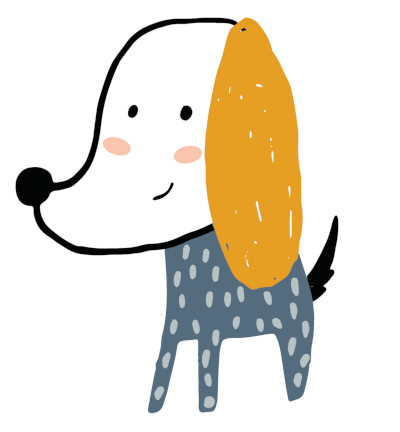
Daisy Responds: Yes, so I urge you to give the plant to a friend who has no pets or children. Though I am smart enough not to chew anything but my dog toys and kibble, my home is free of sago palms and other toxic plants, as yours should be. Sago palm palms are popular indoor houseplants and, in warm climates, often are used as landscape plants.
All parts of the sago palm are poisonous to dogs, cats, and humans. The seeds are so toxic that ingestion of a single seed has caused death in dogs.
Signs of toxicity include vomiting, diarrhea, and loss of appetite. Sago palm toxins damage the liver, stomach, intestines, and nervous system, so immediate veterinary treatment is crucial.
See more at AsktheVetsPets.com.
Featured image: Sago palm (Shutterstock)
Ask the Vet’s Pets: Clawless Cats
Ask The Vet’s Pets is written by Daisy Dog and Christopher Cat, with a little help from Dr. Lee Pickett, VMD. Send questions to Daisy and Christopher at [email protected] and read more online at saturdayeveningpost.com/askthevetspets.
Dear Christopher Cat: I live in New York, where the state just outlawed declawing. My adult cats are declawed, but I recently adopted a kitten who isn’t. How can I prevent her from scratching my furniture?
Christopher Responds: Scratching is a normal feline behavior. One way to protect your furniture is to regularly trim your cat’s claws. The cats in our family were adopted as adults, and our mom used special treats and yummy food to accustom us to the procedure. Try FeliScratch and Feliway innovative visual and pheromone markers that help train cats where to scratch.
If your cat scratches elsewhere, cover the area with double-stick tape or aluminum foil.
Alternatively, you can cover the claws with plastic nail caps, which last four to six weeks. If you have trouble applying them, your veterinary team can do it for you.
Declawing is rejected by many veterinarians and cat lovers as cruel, because it requires amputation of each toe’s third bone, from which the claw grows. It’s like amputating each human finger at the first joint.
Research shows that declawing leads to chronic pain in one percent of cats. Since one in four of the nation’s 96 million household cats undergoes declaw surgery, that’s 240,000 cats with surgically induced chronic pain.
Declawing is illegal in most of the developed world, including the countries of Europe, United Kingdom, Australia, New Zealand, and Brazil.
In the U.S., it’s not just New York that plans to ban declawing. Earlier this year, the New Jersey Assembly passed a similar bill, which still must go through the state Senate.
Some California cities, including Los Angeles, already outlaw cat declawing. Opponents claimed it would lead to increased abandonments and euthanasia, but that hasn’t happened.
See more at AsktheVetsPets.com.
This article is featured in the September/October 2019 issue of The Saturday Evening Post. Subscribe to the magazine for more art, inspiring stories, fiction, humor, and features from our archives.
Featured image: Shutterstock
The Bizarre and Adorable Canine Comics of Robert L. Dickey
A Midwesterner through and through, Robert L. Dickey displayed a peculiar commitment to thick Scottish dialect in portraying his characters Sandy and Jean McNab. The McNabs were a spousal pair of Scottish Terriers in Dickey’s comic strip, “McNab and His Neighbors” that ran in this magazine through the 1920s. Whether the McNabs were beloved because of their innate cuteness or the silliness of lines of dialogue that would nowadays have readers running for a translator app (“It will seem guid to see some one frae home”) is difficult to say. But Dickey — in spite of his decades of animal illustration that may have changed the way we see our pets — has been all but forgotten. The once-celebrated artist has nary a Wikipedia page or accessible obituary.
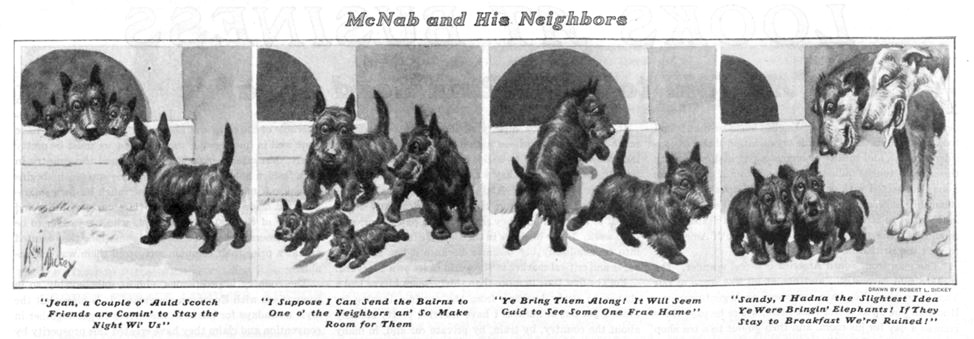
Before drawing adorable pooches, Dickey made his name as a horse illustrator for Chicago’s The Horse Review. As a child, he was enamored with animals, and at a young age he won first prize at the county fair for a drawing of Goldsmith Maid, a legendary mare of harness racing in the 19th century. His winnings amounted to one dollar and a ribbon, but he soon found himself taking commissions from race horse owners and local farmers from his hometown of Marshall, Michigan.
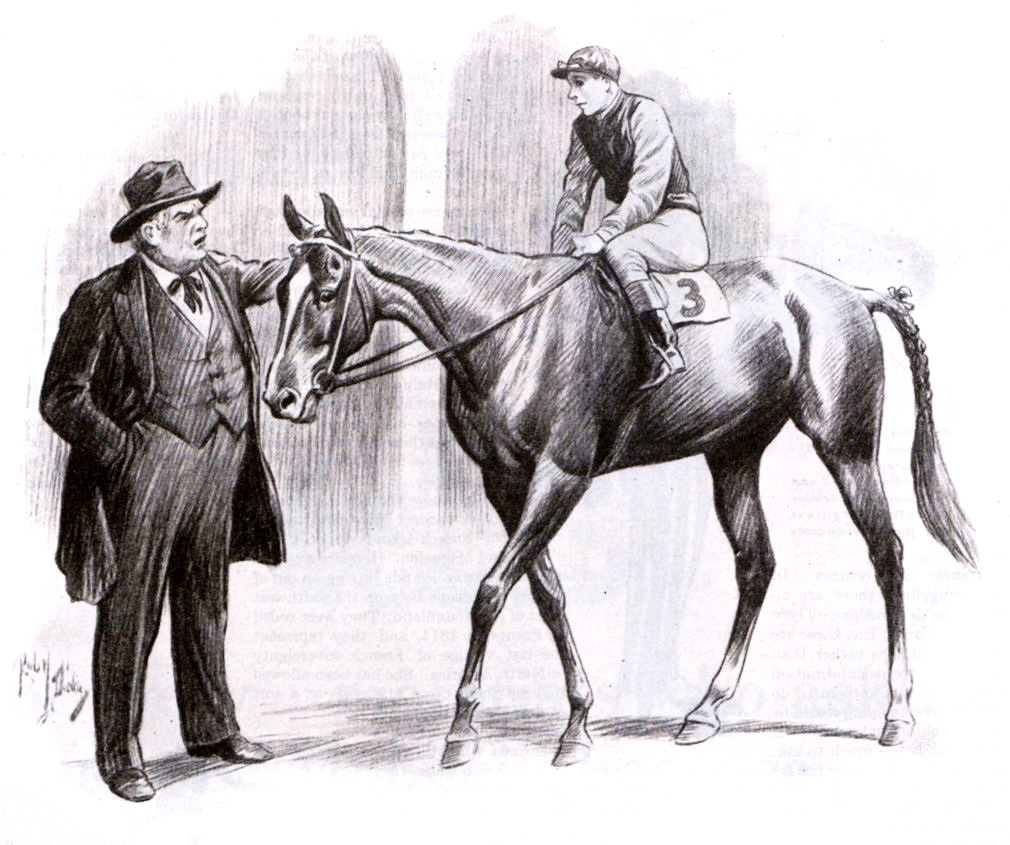
Though he sustained an enthusiasm for horse racing, Dickey’s true artistic muse became the canine. One specific canine, in fact: a white bull terrier named Chimmie Fadden. In the pages of this magazine, in 1929, Dickey proclaimed that his former pet had been a most important art teacher: “His one brindle eye and his two brindle ears could, to me and my family, express all the human emotions; admiration, adoration, adulation were all expressed in the big brown eyes, half hidden beneath the narrow lids of his breed. He could cock one brow in incredulity, and with eye, ear and tail express the utmost contempt.” Of his beloved Chimmie, Dickey also said, “He taught me all the vital things — the things that I have tried hard to get into my drawings — the expression and aliveness that are so important.”
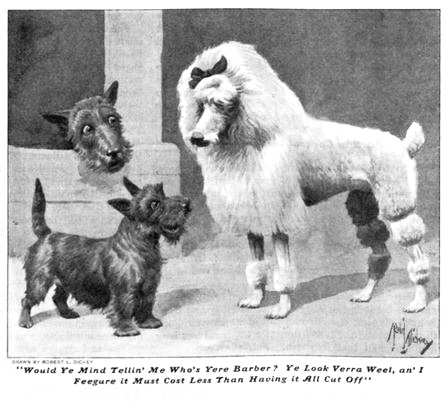
Dickey moved to New York and began publishing comics and illustrations with Life, at the encouragement of editors John Ames Mitchell and Thomas L. Masson. In Dogs from “Life” (1920), Masson calls Dickey “perhaps the best dog artist in this country,” and he credits that success to Life’s guidance, of course. Masson writes that Mitchell advised Dickey to give his dog illustrations more realistic qualities instead of making caricatures: “Don’t make your dogs humorous. You are too good an artist to attempt that sort of thing. Make your dogs true to life — just as they are.”
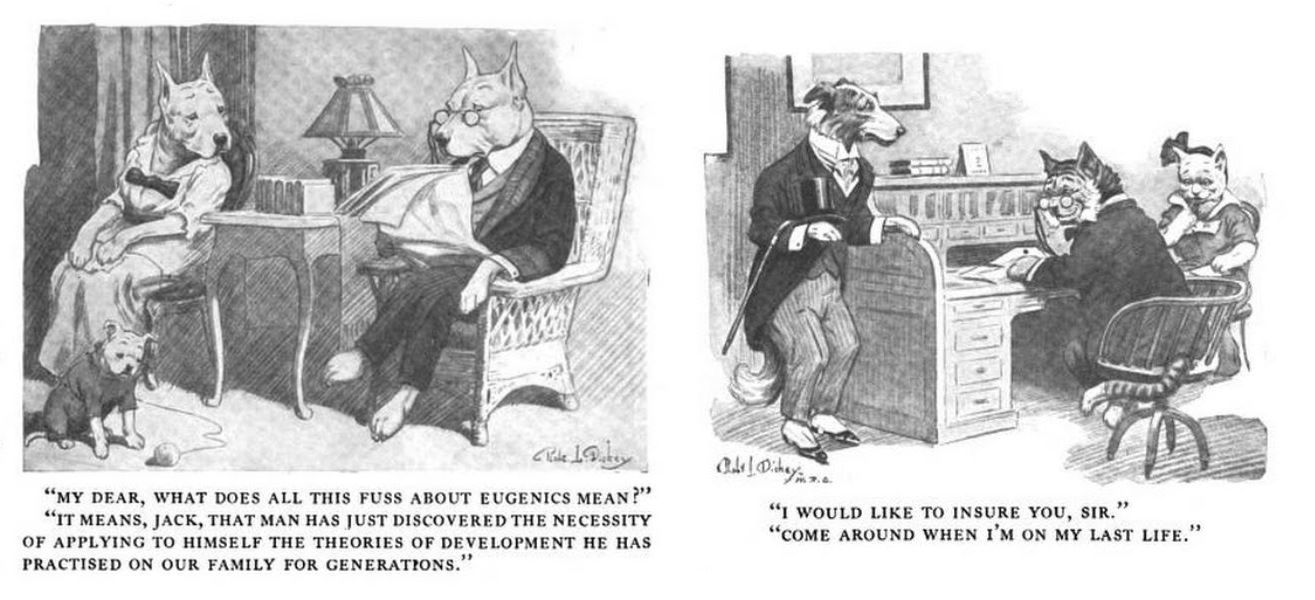
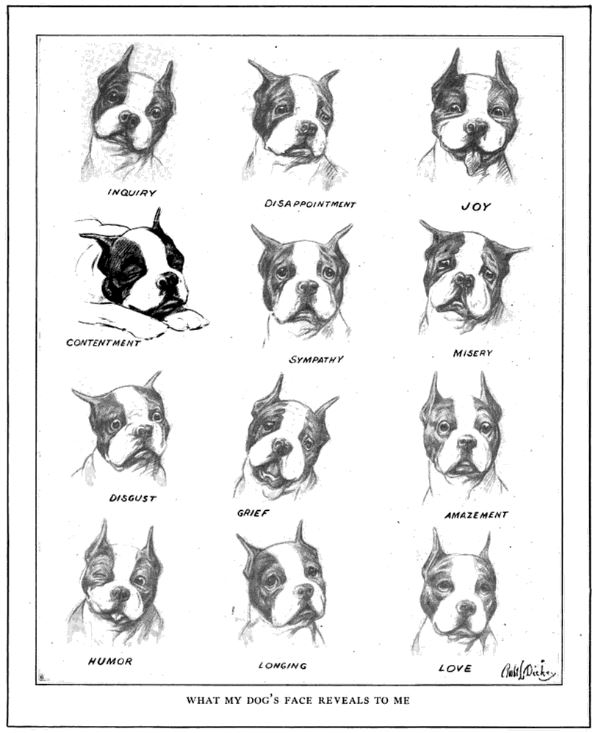
If Dickey followed the Life editor’s advice, he promptly disregarded it for his work in The Saturday Evening Post. After a few tries at political cartoons, Dickey settled in with some recurring characters for the “Short Turns and Encores” section. Throughout the ’20s, in strips like “Timmie and Tatters,” “McNab and His Neighbors,” and “Mr. and Mrs. Beans,” Dickey portrayed cute dogs of various breeds with the humorous hangups and eccentricities of everyday people. With an affinity for terriers, Dickey’s strips showed the lighter side of relationships, middle-class vanity, and machismo.
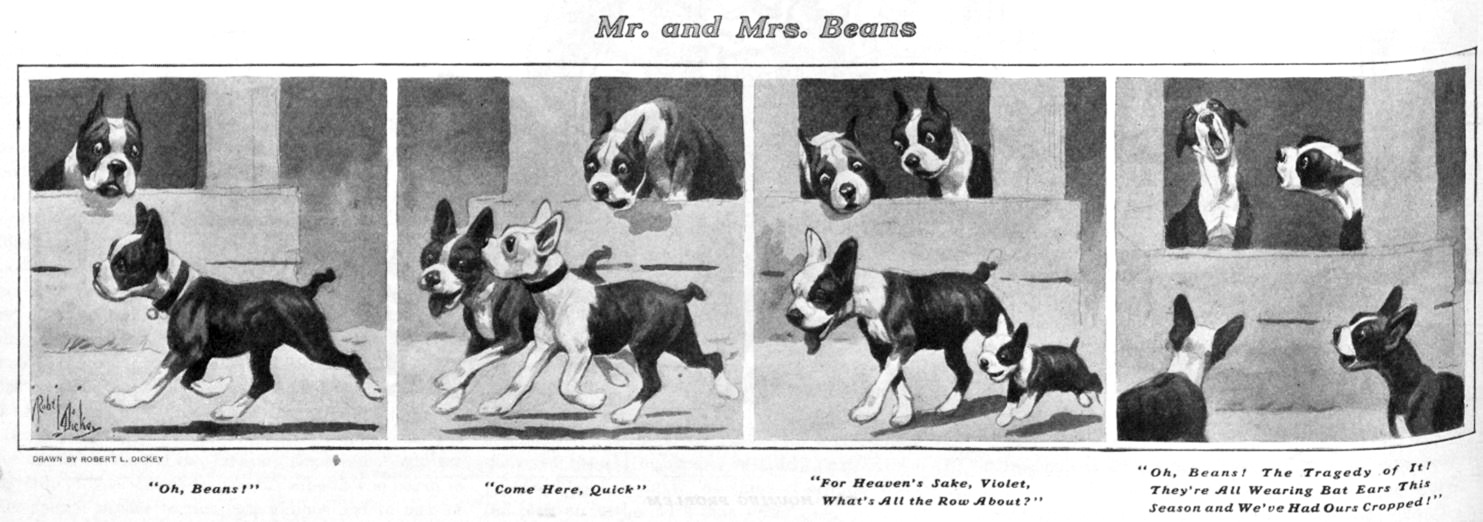
Beans and Violet, Dickey’s signature Boston Terriers in “Mr. and Mrs. Beans,” were named after his own Boston Terriers that travelled with the artist any time he left New York City. Dog historian Cathy Flamholtz credits Dickey for the immense popularity of the breed in the 1920s and ’30s (in Boston Terriers: The Early Years), writing, “While the critics may have scoffed at Robert Dickey’s drawings, the public loved them! Confirmed readers of the most popular magazines fell in love with the clownish dogs seen in the pages of their favorite publications. They wanted one of these dogs and they bought ‘America’s Dog’ in large numbers. Soon, Boston Terriers were one of the most popular breeds in the country.” Flamholtz notes of Dickey’s work in comic strips, tobacco ads, and magazine covers, “The drawings reflect the charm, curiosity, mischievousness, and intelligence of the Boston Terrier. They could only have been made by someone who knew the breed so intimately.”
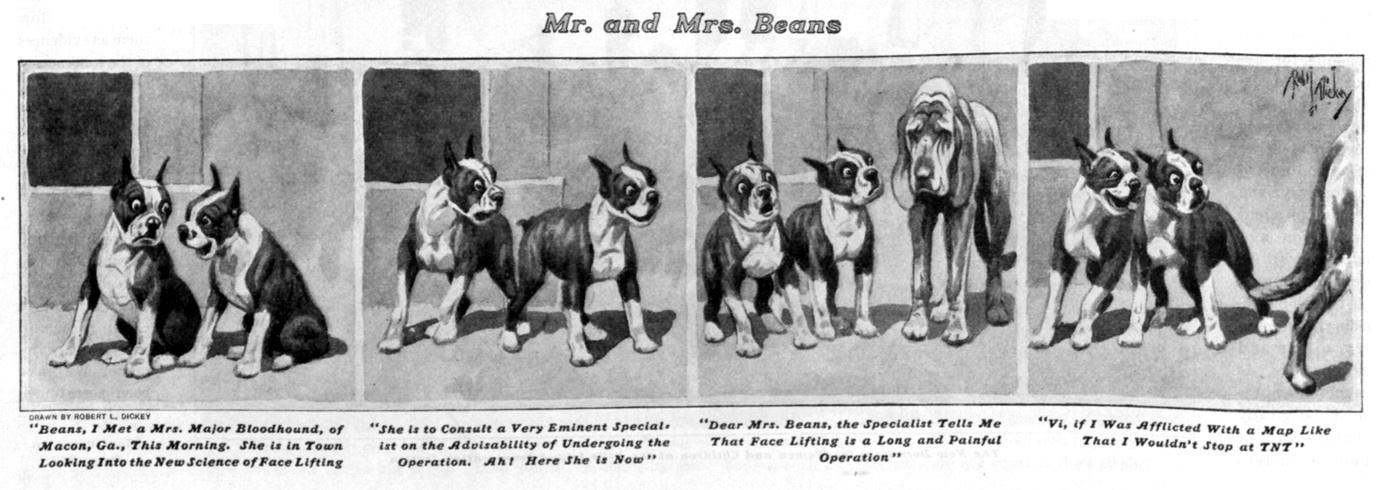
In spite of Dickey’s contributions to American illustration, he is scarcely remembered. His crowd-pleasing comics filled with “puppy dog eyes” and deviant hounds changed the way dogs were rendered in publication and likely altered the way people thought about their four-legged friends. His strips were printed in newspapers around the country as well as Ladies’ Home Journal, Century, and other magazines. He also illustrated the Barse edition of Black Beauty and books like Lad: A Dog and A Dog Named Chips by Albert Payson Terhune. But in his characters, Beans, Violet, and Sandy McNab, Dickey opened the door in the public imagination to the possibility of a dog expressing human faults, joys, and sorrows — and maybe even sporting a Scottish accent.
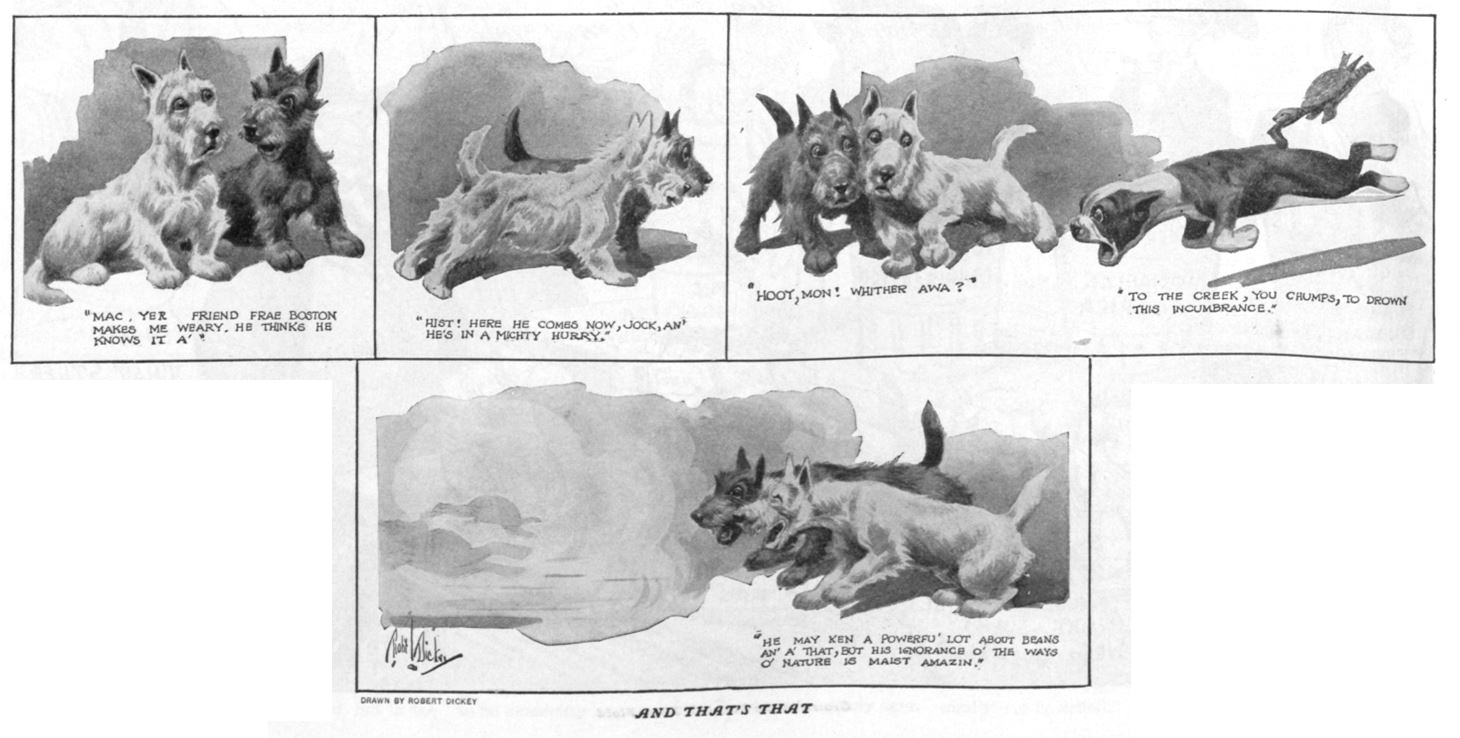
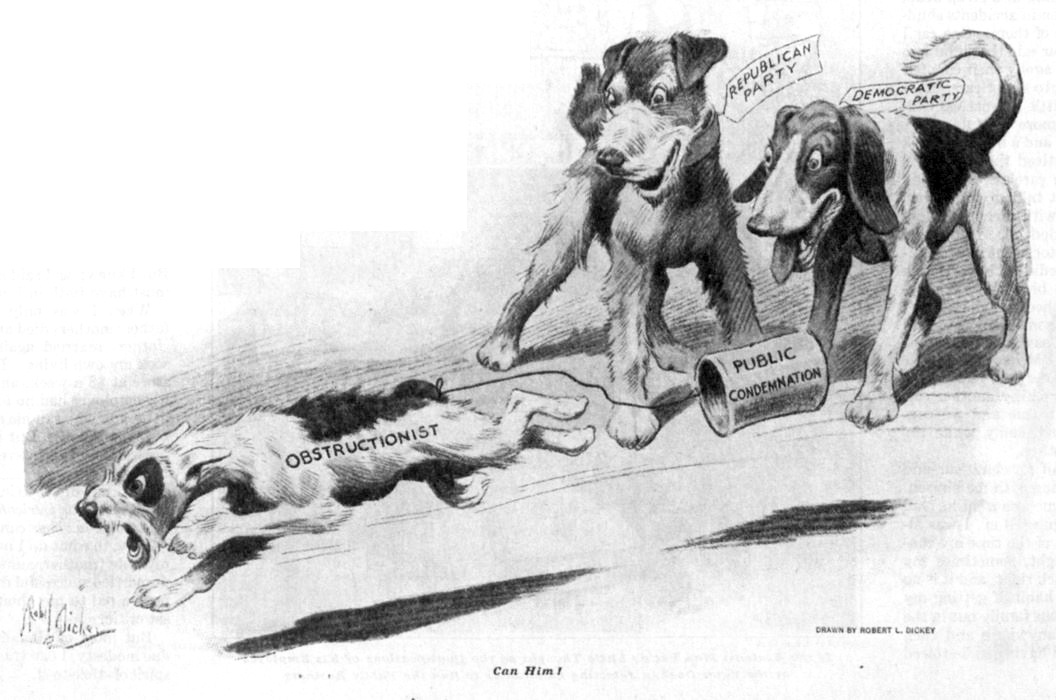
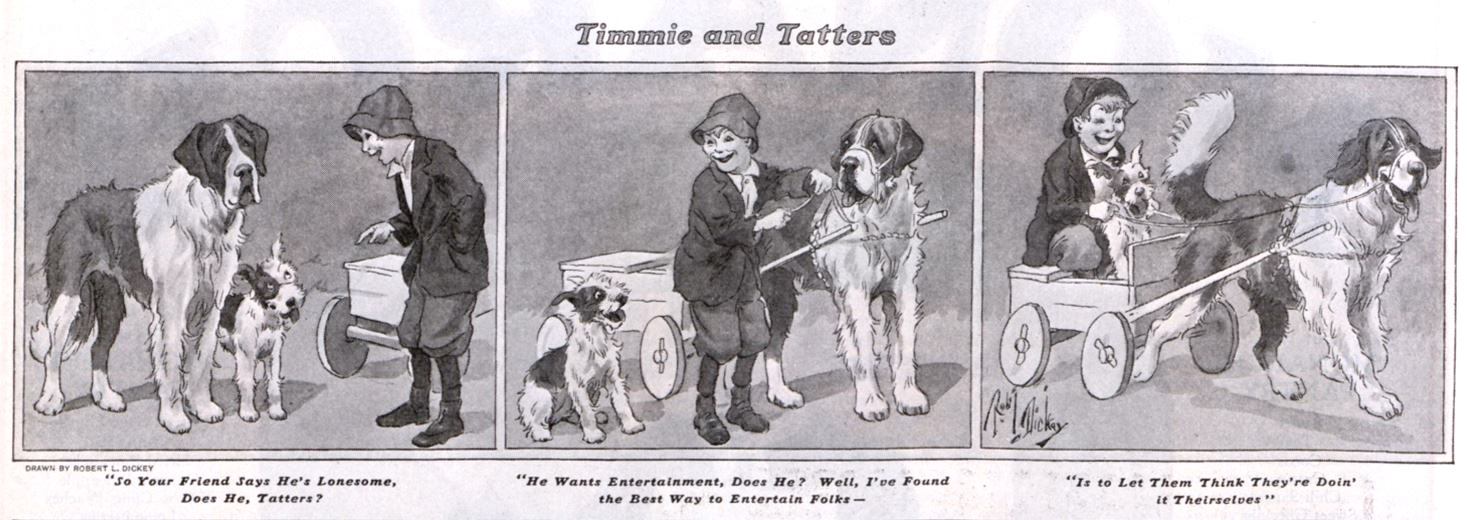
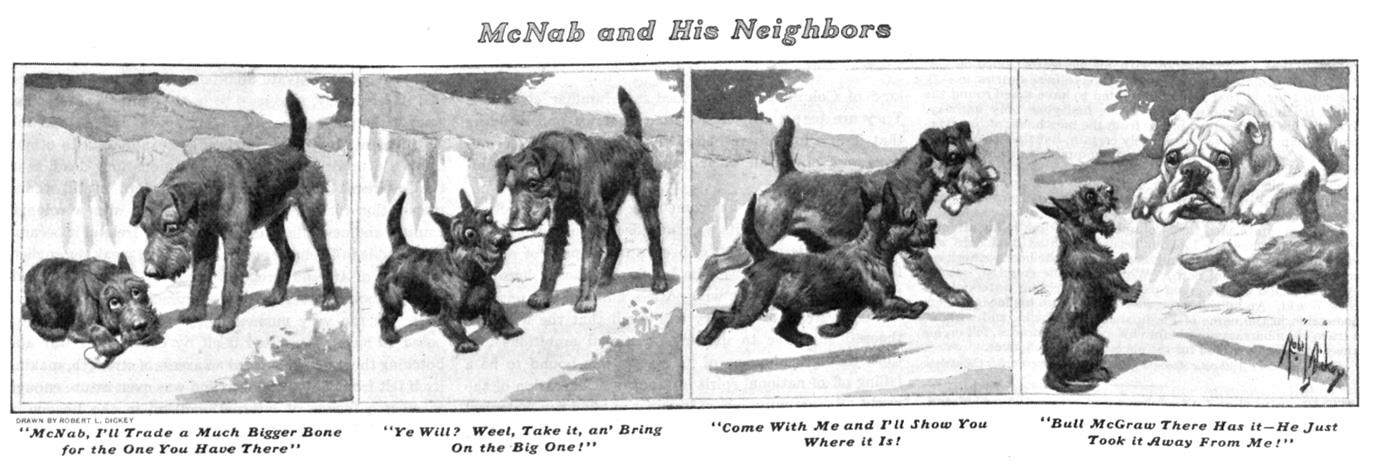
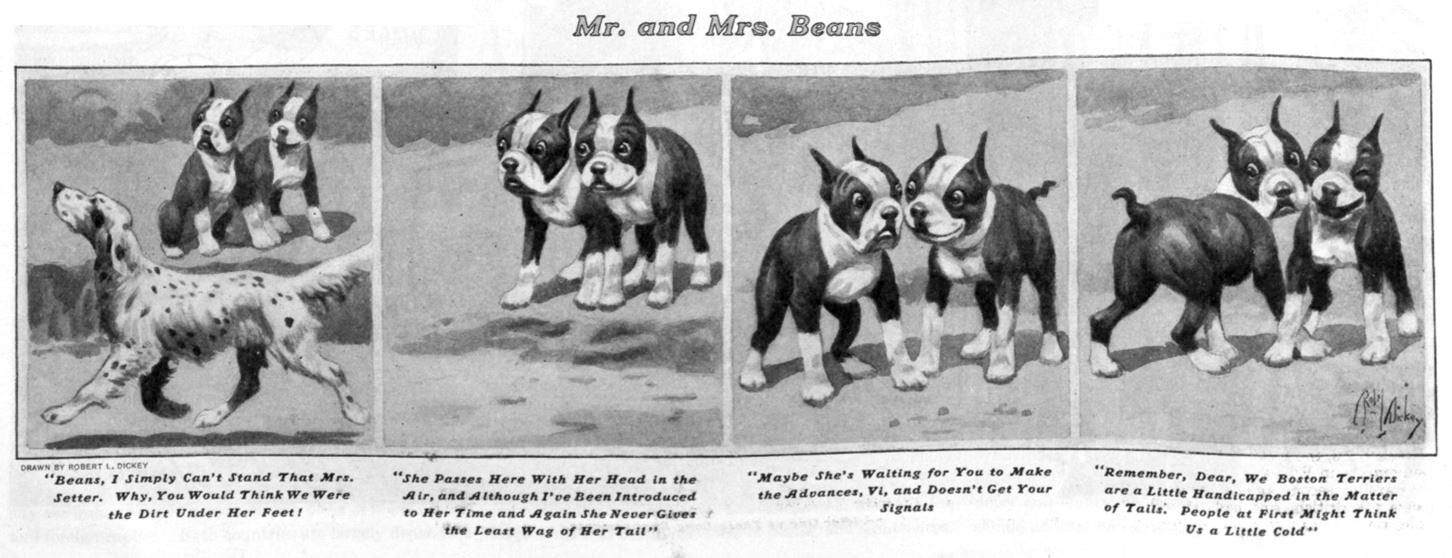
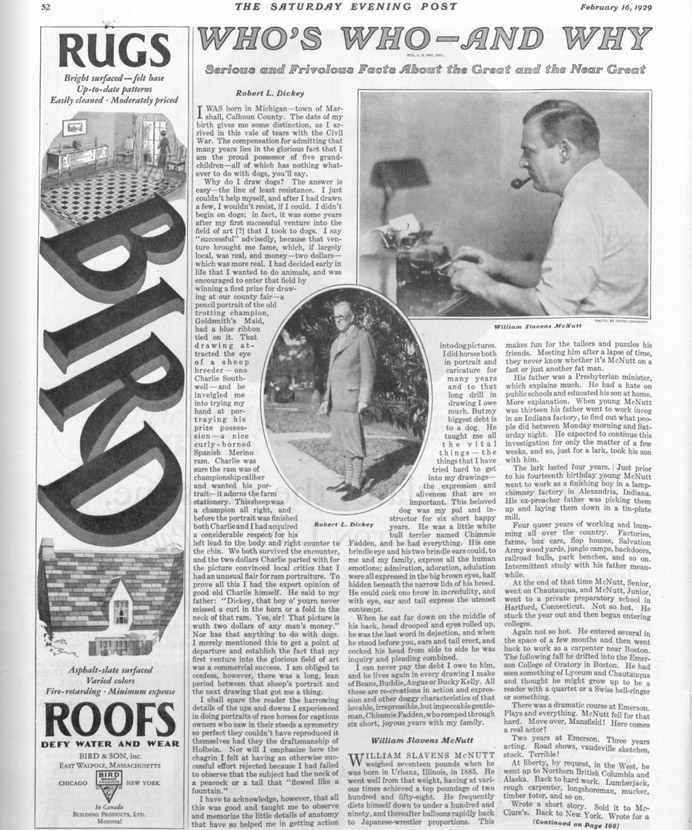
 Order a copy of The Saturday Evening Post: A Celebration of Dogs!, with full-color images by Robert L. Dickey, Norman Rockwell, and more.
Order a copy of The Saturday Evening Post: A Celebration of Dogs!, with full-color images by Robert L. Dickey, Norman Rockwell, and more. Prevent Pets’ Cold Weather Emergencies
Winter’s freezing temperatures bring snow, ice, and the risk of two serious health hazards for your pets: hypothermia and frostbite. Dr. April Finan, a veterinarian at the University of Illinois Chicago Animal ER, offers owners advice on how to avoid a trip to the emergency clinic caused by exposure to the elements.
“Hypothermia occurs when your pet’s core body temperature drops below the normal range of 99.5 to 100.5 degrees F,” says Dr. Finan. “Animals with hypothermia will show signs such as lethargy and weakness. If you suspect this problem, wrap your pet in a warm blanket and get her to a veterinary hospital quickly.”
Dr. Finan warns against placing anything hot, such as a heating pad or warm water bottle, directly against your pet’s skin. This could cause burns.
For pets that enjoy the outdoors, exposure to extreme cold temperatures—below freezing—should be limited to 10 to 15 minutes. It’s important to factor in the wind chill and how much shelter is provided to your pet. Even with above-freezing temperatures, the wind chill can cause pets, especially short-haired pets, to become chilled and potentially hypothermic faster.
Pets that remain outside longer will need access to a warm shelter away from the snow and ice. You’ll also have to find a way to ensure that their water bowl does not ice over.
Surprisingly, some exotic pets can develop hypothermia even if they don’t go outside.
“Many of these pets come from a desert environment,” says Dr. Finan. “The chilly winter time doesn’t suit them well.”
Especially in the winter it is very important to make sure your exotic pets’ heat sources and/or light sources are providing them with the appropriate temperature. Also, be sure to keep these pets away from drafty windows and cold rooms, which can cause the temperature in their enclosures to drop to levels that are not appropriate for these pets.
For pets that spend a great deal of time outside during the wintertime, frostbite is another common concern.
“You should monitor your animal for signs of cold and numbness of the extremities and ears during the winter, especially after prolonged periods outside,” says Dr. Finan. Typically the ears and paws are the first body parts affected.
Despite these cautions, Dr. Finan still encourages owners to take their dogs for walks in the winter.
“Taking pets for a short walk may result in some temporary cold discomfort, but nothing more,” she says.
“If your dog will wear booties on the walk, those can help protect their feet from cold as well as from the salt spread on sidewalks to melt ice, which can irritate the footpads on dogs’ paws,” says Dr. Finan. “Applying a protective ointment such as ‘Musher’s Secret’ to dogs’ paw pads before walks can also help prevent this irritation.”
And what about those adorable doggy jackets and coats to go along with the booties? Dr. Finan thinks for the most part those are more for show than for actual benefit to the pets. However, she says breeds with low body fat and a short hair coat, such as the greyhound, should wear a coat outside during the winter to help prevent hypothermia.
If you have questions about protecting your animal from the cold, please consult your local veterinarian.
Brittany Way Rose is an Information Specialist at University of Illinois’ College of Veterinary Medicine.